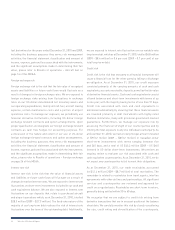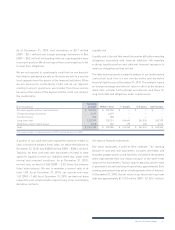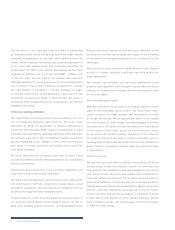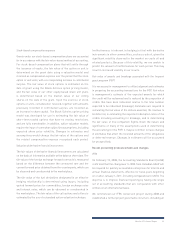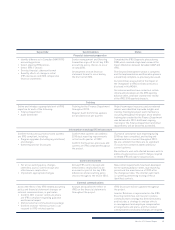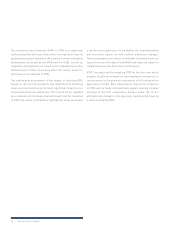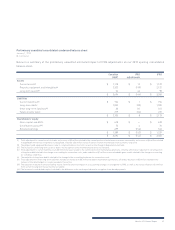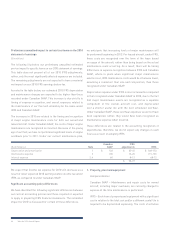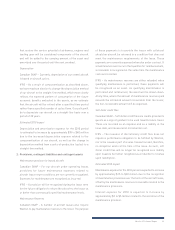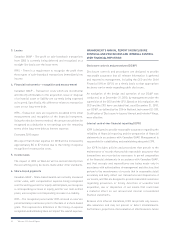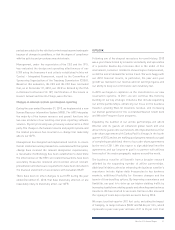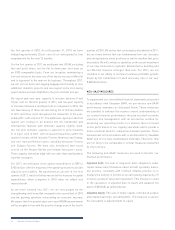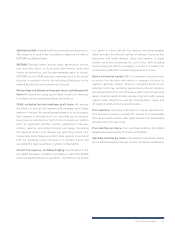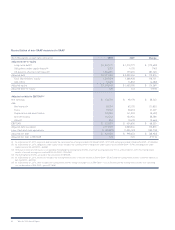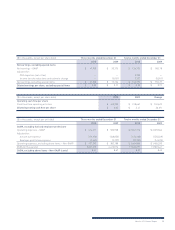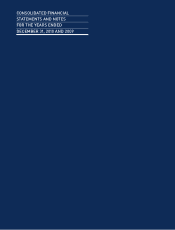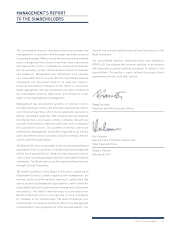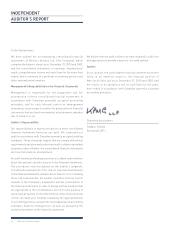Westjet 2010 Annual Report Download - page 52
Download and view the complete annual report
Please find page 52 of the 2010 Westjet annual report below. You can navigate through the pages in the report by either clicking on the pages listed below, or by using the keyword search tool below to find specific information within the annual report.
50 WestJet 2010 Annual Report
3. Leases
Canadian GAAP – The profit on sale-leaseback transactions
from 2005 is currently being deferred and recognized on a
straight-line basis over the lease term.
IFRS – There is a requirement to recognize the profit from
these types of sale-leaseback transactions immediately into
income.
4. Financial instruments – recognition and measurement
Canadian GAAP – Transaction costs which are incremental
and directly attributable to the acquisition, issue or disposal
of a financial asset or liability are currently being expensed
as incurred. Specifically, this difference relates to transaction
costs on our long-term debt.
IFRS – Transaction costs are required to be added to the initial
measurement and recognition of the financial instrument.
Using the effective interest method, the amount would then be
recognized as a deduction to net earnings over the remaining
terms of the long-term debt as interest expense.
Estimated 2010 impact
We expect that interest expense for 2010 will be increased by
approximately $5 to $7 million due to the timing of expense
recognition for transaction costs.
5. Income taxes
The impact of IFRS on WestJet will be derived directly from
the accounting policy decisions made under other standards.
6. Share-based payments
Canadian GAAP – Share-based awards are currently measured
at fair value, with compensation expense being recognized
over the vesting period. For equity-settled plans, we recognize
a corresponding increase in equity, and for our cash-settled
plans, we recognize a corresponding increase in a liability.
IFRS – The recognition period under IFRS is based on a service
period and may commence prior to the date of a share-based
grant. This represents a difference in the timing of expense
recognition and ultimately does not impact the overall expense.
MANAGEMENT’S ANNUAL REPORT ON DISCLOSURE
CONTROLS AND PROCEDURES AND INTERNAL CONTROL
OVER FINANCIAL REPORTING
Disclosure controls and procedures (DC&P)
Disclosure controls and procedures are designed to provide
reasonable assurance that all relevant information is gathered
and reported to management, including the CEO and the Chief
Financial Officer (CFO), on a timely basis so that appropriate
decisions can be made regarding public disclosure.
An evaluation of the design and operation of our DC&P was
conducted, as at December 31, 2010, by management under the
supervision of the CEO and the CFO. Based on this evaluation, the
CEO and the CFO have concluded that, as at December 31, 2010,
our DC&P, as defined by the CSA in National Instrument 52-109,
Certification of Disclosure in Issuers’ Annual and Interim Filings,
were effective.
Internal control over financial reporting (ICFR)
ICFR is designed to provide reasonable assurance regarding the
reliability of financial reporting and the preparation of financial
statements in accordance with Canadian GAAP. Management is
responsible for establishing and maintaining adequate ICFR.
Our ICFR includes policies and procedures that pertain to the
maintenance of records that provide reasonable assurance that
transactions are recorded as necessary to permit preparation
of the financial statements in accordance with Canadian GAAP,
and that receipts and expenditures are being made only in
accordance with authorizations of management and directors; that
pertain to the maintenance of records that in reasonable
detail
accurately and fairly reflect our transactions and dispositions of
our assets; and that are designed to provide reasonable assurance
regarding prevention or timely detection of unauthorized
acquisition, use or disposition of our assets that
could have
a material effect on our annual and interim consolidated
financial statements.
Because of its inherent limitations, ICFR can provide only reason-
able assurance and may not prevent or detect misstatements.
Furthermore, projections of an evaluation of effectiveness to future


